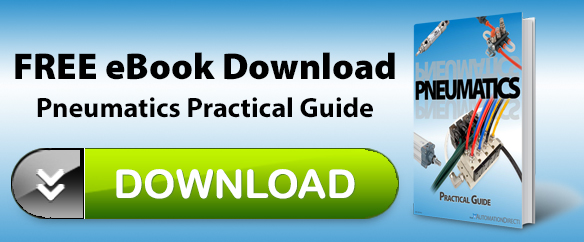To control pneumatic cylinders and actuators with fluid power, air flow must be reliably controlled, typically with a solenoid valve.
Pat Phillips, Product Manager, Fluid Power & Mechanical Products at AutomationDirect, wrote an article titled There’s a Valve for That, which ran in the November-December 2017 issue of IEN magazine. In the article, he discussed the variety of pneumatic solenoid valves available, along with ways to pick the proper type and style for each application.

Selection Criteria
Control of pneumatic motion extend, retract, open and close actions starts with clean, dry air supplied and exhausted from cylinders and actuators using pneumatic valves, often called directional control valves. Several selection criteria for pneumatic valves were discussed in the article as noted in Table 1.
Selection Criteria for Pneumatic Valves
- Valve actuation
- Valve types and configurations
- Number of ports and position
These directional control valves can be operated manually, or they can be solenoid-operated or air-piloted. Phillips mentions manual valves such as food pedals, toggle actuators, pushbutton and handles—and also discusses other valve types.
“Automated machines typically use solenoid-operated or air-piloted solenoid valves. These valves are usually activated using 12 Vdc, 24 Vac/dc or 120 Vac power. Air-piloted solenoid valves use a small electrically operated valve spool to switch air that operates a larger main valve spool, minimizing the amount of electrical energy needed to control the valve. These valves have a minimum operating pressure needed to shift the spool.”
Phillips talks about how pneumatic valves switch air using poppet, diaphragm and spool configurations, and covers the common pneumatic valve types listed in Table 2.
Common Pneumatic Valve Types
- 2-port (2-way), 2-position
- 3-port (3-way), 2-position
- 5-port (4-way), 2-position
- 5-port (4-way), 3-position
“The type of work a pneumatic valve can do depends on the number of ports and positions, with several valve types available. The number of different pathways by which air can flow in or out of a valve are called “ways”. The number of states a valve has are referred to as “positions”. Regardless of the valve type, all valves have an air inlet port (P), and one or two air outlet ports (A, or A and B).”

Phillips explains operation of 2-port or 2-way, 2-position valves with one inlet and one outlet port so it is either open or closed as would be use for an air blow off. He also shows how a 3-way valve adds an exhaust port to fill or empty a pressure vessel.
“Adding an extra exhaust port is common, but it can cause confusion with some valve types. For example, a 5-port valve is still a 4-way valve with two exhaust ports, often labeled R and S. These ports are open to atmosphere, so they are the same “way”. With a 5-port valve, there is also an inlet port (P) and two outlet ports (A and B).”
Phillips explains how to understand and use 5-port valves, commonly used in fully automated machines.
“5-port valves are available in 2- and 3-position models. With 5-port, 2-position valves, the A and B output ports are in complementary mode. When one is supplied inlet air pressure, the other exhausts air, which works well for extending and retracting double-acting cylinders. 2-position valves are often spring return. During design, consider unintended cylinder motion after an emergency stop or during power on.”
A center or neutral position is available in a 5-port, 3-position valve. Phillips notes that with both solenoids de-energized, the center position will either supply pressure to both output ports, block both outlets, or exhaust pressure from both. “A closed center valve works well when holding a cylinder position. The center exhaust is used to dump air from a cylinder when not actuated, usually for safety reasons.”
AutomationDirect hopes this blog provided you a brief overview of pneumatic valves and some applications. And if you want to know more, download this comprehensive eBook, Practical Guide to Pneumatics, to help advance your pneumatic knowledge.
For more information on solenoid valves check out our valves overview page!


